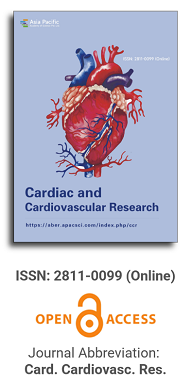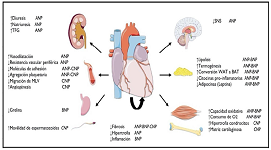
Asia Pacific Academy of Science Pte. Ltd. (APACSCI) specializes in international journal publishing. APACSCI adopts the open access publishing model and provides an important communication bridge for academic groups whose interest fields include engineering, technology, medicine, computer, mathematics, agriculture and forestry, and environment.

Heart conditioning as healthy strategy in management of aortic stenosis: A case report
Vol 5, Issue 2, 2024
Download PDF
Abstract
Introduction: Heart conditioning can be utilized as a healthy strategy in the reversion of disease and ageing. In this sense, heart conditioning may benefit the aortic stenosis patients. Case presentation: We describe the case of an 82-year-old man with moderate to severe aortic stenosis (aortic valve area 1.01 cm2 with peak pressure gradient 56.7mmHg) who refused valvular intervention. He was treated conservatively with antianginal drugs, and remote ischemic preconditioning as a healthy strategy was delivered once daily. To our surprise, 27 months later, follow-up transthoracic echocardiography showed an aortic valve area of 1.41 cm2. His symptoms were dramatically relieved. Conclusions: This case indicates that heart conditioning as a healthy regimen is a valuable safe and effective adjunctive treatment in aortic stenosis patients, which could affect cardiac reverse remodeling and recovery as well as quality of life.
Keywords
References
- Carabello BA, Paulus WJ. Aortic stenosis. Lancet. 2009; 73:956–966.
- Baumgartner H, Hung J, Bermejo J, et al. Recommendations on the echocardiographic assessment of aortic valve stenosis: A focused update from the European association of cardiovascular imaging and the American society of echocardiography. European Heart Journal—Cardiovascular Imaging. 2017; 18:254–275.
- Chen KL, Two K, Dumesnil TG, et al. Effect of lipid lowering with rosuvastatin on progression of aortic stenosis: Results of the aortic stenosis progression observation: Measuring effects of rosuvastatin (ASTRONOMER) trial. Circulation. 2010; 121:306–314.
- Murry CE, Jennings RB, Reimer KA. Preconditioning with ischemia: A delay of lethal cell injury in ischemic myocardium. Circulation. 1986; 74:1124–1136.
- Sumeray MS, Yellon DM. Characterization and validation of a murine model of global ischemia-reperfusion injury. Molecular and Cellular Biochemistry. 1998; 186:61–68.
- Schott RJ, Rohmann S, Braun ER, Schaper W. Ischemic preconditioning reduces infarct size in swine myocardium. Circulation Research. 1990; 66:1133–1142.
- Cave AC, Hearse DJ. Ischemic preconditioning and contractile function: Studies with normothermic and hypothermic global ischemia. J. Mol. Cell.Cardiol. 1991; 24:1113–1123.
- Shiki K, Hearse DJ. Preconditioning of ischemic myocardium: Reperfusion-induced arrhythmias. Am. J. Physiol. 1987; 253:H1470–1476.
- Vegh A, Komori S, Szekeres L, Parratt JR. Antiarrhythmic effects of preconditioning in anesthetized dogs and rats. Cardiovas Research. 1992; 26:487–495.
- Piot CA, Padmanaban D, Ursell PC, et al. Ischemic preconditioning decreases apoptosis in rat hearts in vivo. Circulation. 1997; 96:1598–1604.
- Leslay WK, Beach D. Frequency and clinical significance of ischemic preconditioning during percutaneous coronary intervention. J. Am. Coll. Cardiol. 2003; 42:998–1003.
- Walsh SR, Tang TY, Kullar P, et al. Ischemic preconditioning during cardiac surgery: Systemic review and meta-analysis of perioperative outcomes in randomized clinical trials. Eur. J.Cardiothorac. Surg. 2008; 34:985–994.
- Heusch G, Botker HE, Przyklenk K, et al. Remote ischemic conditioning. J. Am. Coll. Cardiol. 2015; 65:177–195.
- Thielmann M, Kottenberg E, Kleinbongard P, et al. Cardioprotective and prognostic effects of remote ischemic preconditioning in patient undergoing coronary artery bypass surgery: A single-centre randomized, double-blind, controlled trial. Lancet. 2013; 382:597–604.
- Hoole SP, Heck PM, Sharples L, et al. Cardiac remote ischemic preconditioning in coronary stenting (CRISP) study: A prospective, randomized control trial. Circulation. 2009; 119:820–827.
- Davies WR, Brown AJ, Watson W, et al. Remote ischemic preconditioning improves outcome at 6 years after elective percutaneous coronary intervention: The CRISP stent trial long-term follow-up. Circ. Cardiovasc. Interv. 2013; 6:246–251.
- Crimi G, Pica S, Raineri C, et al. Remote ischemic postconditioning of the lower limb during primary percutaneous coronary intervention safely reduces enzymatic infarct size in anterior myocardial infarction: A randomized controlled trial. JACC Cardiovasc. Interv. 2013; 6:1055–1063.
- Wei M, Xin P, Li S, et al. Repeated remote ischemic postconditioning protects against adverse left ventricular remodeling and improves survival in a rat model of myocardial infarction. Circulation Research. 2011; 108:1220–1225.
- Lee AYS. Heart conditioning and heterchronic parabiotic models as healthy strategies. Medicine, Environmental Science. 2023; 5:6.
- Aimo A, Gaggin HK, Bavison A, et al. Imaging, biomarker and clinical predictors of cardiac remodeling in heart failure with reduced ejection fraction. JACC:Heart Failure. 2019; 7(9):782–794.
- Lupon J, Gaggin HK, De Antonio M, et al. Biomarker-assist score for reverse remodeling prediction in heart failure: The ST2-R2 score. Int. J.Cardiol. 2015; 84:337–343.
- Mathias A, Moss AJ, McNitt S, et al. Clinical implications of complete left-sided reverse remodeling with cardiac resynchronization therapy: A MADIT-CRT substudy. J. Am. Coll.Cardiol. 2016; 68:1268–1276.
Supporting Agencies
none
Copyright (c) 2024 William Wing-Ho Lee, David Wing-Ching Lee, Andrew Ying-Siu Lee
License URL: https://creativecommons.org/licenses/by/4.0/

This site is licensed under a Creative Commons Attribution 4.0 International License (CC BY 4.0).

Prof. Prakash Deedwania
University of California,
San Francisco, United States




